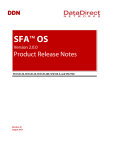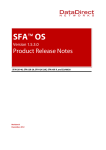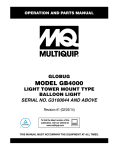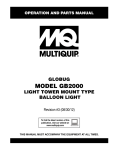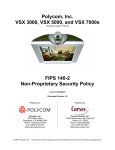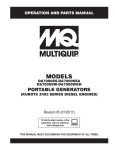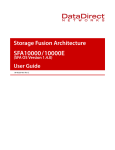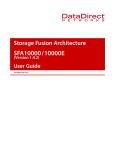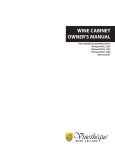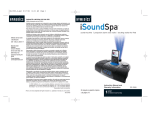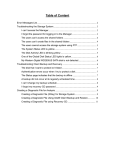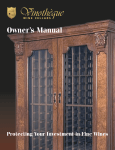Download Vinotheque Wine Cellars Owner`s manual
Transcript
WhisperKOOL by Vinothèque “THE COOLEST THING IN WINE STORAGE.” Split System SS4000 & SS7000 Split Refrigeration System Liquid Line 115 VAC 115 VAC Suction Drain Evaporator Condensing Unit (Indoor) (Indoor/Outdoor) ! The WhisperKOOL Split Cooling System requires professional installation by a Certified HVAC\R technician. Thank you for choosing WhisperKOOL Split Cooling System for your wine preservation needs. This unit has been specifically designed and engineered to create the ideal balance of temperature and humidity within a wine cellar. This, along with a properly designed and constructed cellar, creates the optimum environment for the proper aging of fine wine. Please take the time to read through the owner’s manual so you understand the correct operations of the WhisperKOOL unit. Copyright ©1998-2008 Vinothèque Wine Cellars All rights reserved. This manual, the product design, and the design concepts are copyrighted by Vinothèque Wine Cellars, with all rights reserved. Your rights with regard to the hardware and manual are subject to the restrictions and limitations imposed by the copyright laws of the United States of America. Under copyright laws, this manual may not be copied, reproduced, translated, transmitted, or reduced to any printed or electronic medium or to any machine-readable form, for any purpose, in whole or in part, without the written consent of Vinothèque Wine Cellars. Every effort has been made to ensure that the information in this manual is accurate. Vinothèque Wine Cellars is not responsible for printing or clerical errors. Vinothèque Wine Cellars reserves the right to make corrections or improvements to the information provided and to the related hardware at any time, without notice. Vinothèque and WhisperKOOLare registered trademarks of Vinothèque Wine Cellars. All rights reserved. Mention of third-party products is for informational purposes only and constitutes neither an endorsement nor a recommendation. Vinothèque Wine Cellars assumes no liability with regard to the performance or use of these products. Revised March 1, 2008 TABLE OF CONTENTS WhisperKOOL Split Cooling System Features & Benefits....................................................................................... 4 System & Features......................................................................................... 5 PDT Thermostat Operating Instructions...................................................... 6 Package Contents........................................................................................... 7 Wine Cellar / Space Preparation................................................................... 8 Technical Specifications................................................................................. 8 Split System Installation Guidelines............................................................. 9 Condensing Unit Skid Preparation........................................................10 Head Pressure Control, Low Ambient Control Switch...........................11 Mounting the Evaporator Unit.............................................................. 12 Split System Wiring Schematic.............................................................19 Refrigeration Lines...............................................................................19 Wiring system...................................................................................... 19 Charging the system........................................................................... 21 Maintenance.................................................................................................. 21 Technical Assistance.................................................................................... 22 Troubleshooting........................................................................................... 23 Installation Terms and Conditions.............................................................. 28 -3- FEATURES & BENEFITS Designed specifically for wine storage, the WhisperKOOL system is a specialized refrigeration unit designed for one purpose only: to maintain the optimal temperature and humidity levels conducive to the proper aging of fine wines. Humidity Control As the temperature begins to drop within the cellar, the relative humidity will rise. The WhisperKOOL units do not create humidity. If you live in a dry area of the country, you may need to add humidity in the wine cellar. This can be done by introducing a non-heat humidifier or installing a small fountain within the cellar. The WhisperKOOL will remove excess humidity from the air and discharge it through the drain line hookup on the evaporator unit. Quiet Operation Years of experience with our self contained cooling units has resulted in a totally new design which accounts for a number of environmental conditions unique to wine cellars. We have accounted for these variables and incorporated the use of state of the art components which offer quiet and sophisticated operations while keeping the basic concept rather simple. Condensing Unit Installation, Indoors or Outdoors This system offers the option of installing the condensing unit indoors or outdoors. This will allow home builders and architects to incorporate this system with the utmost ease with regard to installation and space requirements. Note: Exterior installations require a condensing unit housing. Please specify the need of this requirement at the time of order. Temperature Differential The WhisperKOOL split system is designed to operate effectively when the condensing unit (outdoor section) is running in an ambient temperature of up to 125 degrees. At this extreme condition, the system is able to maintain a 70 degree differential between the Wine Cellar temperature at 55 degrees and the 125 degree ambient temperature. This is a significant improvement over most cooling units designed for wine storage. -4- System & Features The system includes both the evaporator and condensing units packaged in two (2) separate containers. An exterior housing is required for outdoor installations and will arrive packed separately. Evaporator Condensing Unit (Shown With Housing) Thermostat The split system evaporator has been designed to incorporate the Vinothèque PDT ™ series thermostat. Years of research and testing have gone into the design of the PDT thermostat resulting in advanced microprocessor controlled digital technology and pinpoint accuracy. This system incorporates a probe designed to measure the liquid temperature in a wine bottle rather than the air temperature of the cellar. This results in several distinct advantages: • Wine is maintained at a precise, measured temperature. • The unit will switch on/off less often, extending cooling unit life. • The unit will run longer during cycles effectively maintaining humidity. Additional Features: Digital probe - contains a microchip which communicates back and forth to the thermostat resulting in accuracy. Heavy Duty Circuitry - designed to resist power surges, which play havoc on sensitive electrical components. Fahrenheit and Celsius readout - for use in the United States as well as around the world. -5- PDT Thermostat PDT OPERATING INSTRUCTIONS The unit is set at 55°F at the factory. To raise or lower the temperature set point, press the set button while at the same time pressing either the arrow up or arrow down button. 1 WINE Temperature Indicator Wine Temperature Reading WINE ON SET 2 3 LED Screen PDT 55F Precision digital Technology Thermostat Temperature SET 4 5 7 Temperature SET Indicator Unit ON Indicator 6 UP Arrow Button 8 DOWN Arrow Button SET Temperature Button 1. Wine Temperature Indicator: A red LED bar will light up when the thermostat is reading the liquid temperature in the bottle via the probe. This will remain lit and the temperature you see displayed is what the probe is reading. 2. LED Screen: Displays your thermostat readings. 3. Wine Temperature Reading: The temperature the water bottle is registering to the thermostat. 4. Temperature SET Indicator: A red LED bar will light up when you are setting the temperature. 5. Unit ON Indicator: A red LED bar will light up every time the unit turns on to run a cooling cycle. 6. SET Button: Used to set the temperature you want the unit to maintain. 7. UP Arrow Button: Used with the SET button to set temperature higher. In addition, by pressing and holding the button it will allow you to see the 5-minute count down. 8. DOWN Arrow Button: Used with the SET button to set temperature lower. *Up and Down Arrow Buttons used simultaneously will change the temperature read out from Fahrenheit to Celsius* -6- PACKAGE CONTENTS SS4000 Box 1 Evaporator Unit (part #: 03-4000SS-0120) Sight Glass Filter Drier Box 2 Condensing Unit (part #: 1-122100) Accessory Kit (par #: 09-950-9997SS) Box 3 Optional Exterior Housing (part #: 03-4000SS-0120) Mounting Hardware Optional Electrical Cover SS7000 Box 1 Evaporator Unit (part #: 03-7000SS-0120) Sight Glass Filter Drier Box 2 Condensing Unit (part #: 1-122101) Accessory Kit (part #: 09-950-9997SS) Box 3 Optional Exterior Housing (part #: 03-7000SS-0120) Mounting Hardware Optional Electrical Cover Accessory Kit Brass Fitting, 3/8” Barb x 1/8 Brass Nipple, 1/8” Male Pipe Bypass Plug Jumper w/Molex Drain Line & Fitting Owner’s Manual Screw #8 x 1-3/4 SH Black part #: 09-950-9997SS 1-141012 1-141025 1-212455 N/A M-4/7SS RevA 1-422813B -7- Quantity 1 1 1 1 1 9 WINE CELLAR / SPACE PREPARATION Preparing the Wine Cellar The proper design and preparation of the wine cellar is essential in order to maintain the ideal temperature and humidity levels. We have created a typical presentation on “How to Build a Wine Cellar” which is available for viewing on our web site at www.whisperkool.com. Failure to prepare the cellar accordingly will result in the cellar not maintaining proper temperature and humidity. Technical Specifications Sizing Guide & Specifications Cellar Volume Run Amps SS4000 Condensing Unit 1000 cu. ft. 10.3 Amps Minimum Circuit Amps 15 Amps SS4000 Evaporator 1000 cu. ft. 1.0 Amp 2 Amps SS7000 Condensing Unit 1750 cu. ft. 12.0 Amps 18 Amps SS7000 Evaporator 1750 cu. ft. 1.0 Amps 2 Amps Vinothèque model Outside Enclosure (All) NA NA NA Ton 1/3 7/12 NA HxWxD Lbs 13.5”x18.5”x12” 56 15.75”x23.5”x15.5” 60 13.5”x18.5”x12” 66 15.75”x23.5”x15.5” 60 20.75”x25.75”x18” 30 Power Source Condenser -115Volt, 20Amp Dedicated (Non-GFI) Breaker Evaporator -115Volt, 15Amp Dedicated (Non-GFI) Breaker Refrigerant Lines and Wiring • 1/4” OD copper liquid line • 1/2” OD copper suction line. If longer than 75’, use 5/8” OD pipe. If there is a vertical rise of more than 10’, reduce to 3/8” OD pipe for the rise. • 1/2” wall thickness Armaflex (brand name) or equal insulation for suction line • For suction lines where elbows are required, use “long radius” 90° elbows to reduce friction loss. Each 90° elbow equals 1ft. equivalent feet of tubing length. Add the equivalent footage for the total number of 90° elbows to the length of straight tubing with the total not to exceed 100’. -8- SPLIT SYSTEM INSTALLATION GUIDELINES General Installation Guidelines and Instructions Vinothèque requires that a certified HVAC technician install and pipe the Split System unit modules. Please take a moment to review State and City building codes to insure the safe and proper installation of the unit. Installing Condensing Unit The condensing unit can be mounted inside a utility area of the home or outside utilizing the required outdoor condensing unit housing. The system will operate on a 70 degree temperature differential. This means that the unit will keep the wine cellar at 55 degrees when the outside temperature is 125 degrees and will have the capacity to produce cool air into the cellar as long as the ambient temperature does not exceed 125 degrees Fahrenheit. This unit requires a dedicated 20 amp circuit, non-GFI. Make sure there is a minimum three-foot horizontal clearance in front and rear of the unit. The unit may either be hard wired or plug-in depending on local electrical codes. Internal Condensing Unit Installations. Internal (i.e., inside the building) installations require special consideration by having adequate ventilation to dissipate the heat created during normal operations. An exhaust port with fan may need to be installed to assure that heat is effectively removed from the utility room. A return grille or provision for 500 - 600 cfm of cool air to enter the room to replace the exhausted air will accomplish this. Unobstructed airflow to and from the unit is a critical factor in the unit’s overall performance. Make sure there is a minimum three-foot horizontal clearance in front and rear of the unit. This will assure that the unit can move the air around the room in an efficient manner. Outdoor Condensing Unit Installations. You must utilize the exterior condensing unit housing for outdoor installations. Place the condensing unit on a solid foundation in a location with adequate ventilation. There should be three feet for clearance in the front and rear of the unit and one foot on each side. The unit should be elevated 18 inches in order to avoid any possible flooding or damage by animals, and should be clear of leaves, dirt, and other debris. Mounting Evaporator Unit The evaporator unit should be mounted level and the top of the unit needs to be 6” inches or less from the ceiling of the cellar in order to deliver sufficient cooling. As the room cools down, warm air will rise to the ceiling, which is then captured into the cooling unit in order to create a consistently cool environment. Mounting the unit low in the room will result in a temperature variation due to cold air puddling on the floor and the unit’s inability to draw warm air down from the ceiling into the unit itself. Unobstructed Airflow Unobstructed airflow to and from the unit is a critical factor in the unit’s overall performance. -9- CONDENSING UNIT SKID PREPARATION Note: The condensing unit is shipped with a protective foam pad/ block to prevent damaging tubing against the condenser coil fins. Please ensure that this pad is removed prior to operation. Condensing Unit -10- Head Pressure Control, Low Ambient Control Switch: The switch is used to cycle the condenser fan at low ambient temperature condition. Set the switch to 170 psig for cut-in and 70 psig for the differential. Further adjustment may be needed. Verify the settings via refrigeration manifold gauge and perform the final adjustments to the readings on the gauge manifold. Low Ambient Control* High Pressure Cutout Low Pressure Cutout Condensing Unit * Low ambient control is in the control box -11- MOUNTING THE EVAPORATOR UNIT 1. Disassemble evaporator unit. In order to mount the housing to the wall, the internal components will need to be removed and reinstalled after mounting the housing. Remove front cover and thermostat by unscrewing four captive screws located on each corner of the cover and five at bottom of front cover. Note: Thermostat is not plugged into electrical line. 2. Remove interior assembly. The interior assembly is one piece. The assembly should slide out on mounting rails as one piece. -12- 3. Identify and remove appropriate knockouts. There are knockouts located on the rear panel, right side panel and on top. Remove knockouts for the two refrigeration lines and install the two grommets supplied. Remove knockout for electrical line. Keep the refrigerant pipes capped to prevent any foreign material from entering, until ready to braze. 4. Mounting housing to wall. The unit has six mounting holes on 16 inch wide centers. Utilize all mounting screws to secure the housing to the wall (screws not included). 18 6” inches -13- 5. Installing refrigeration lines into evaporator housing. With knockouts removed, install grommets supplied. Install housing, mark location and center line of holes to be drilled in wall. Slide interior into place, measure the distance from the suction and liquid line connection locations to the housing knockout opening. Add that dimension to the length of pipe necessary to penetrate the wall for a rear entry plus enough for an elbow connection if the pipe is to run up or down the wall on the back side of the unit. A 1/2” 90° long radius elbow will be required to connect to a nipple from the suction line and to either a vertical riser through a ceiling opening or to extend the pipe through the right side of the housing opening and adjacent wall. Add enough length for the pipes to pass through the wall and connect to another fitting. Since the piping is parallel to the evaporator coil and the coil is at an angle with the housing, the “through the rear” or “side wall pipes” will have to be formed inside the housing to match that angle prior to connecting. The 90° elbow on the vertical riser can be adjusted to the proper angle to fit the nipple from the elbow to the coil suction line connection. With measurements taken, remove the interior assembly and the housing. Drill a 1 1/2” hole for the 1/2” O/D suction pipe plus the 1/2” wall thickness cellular insulation and 1/4” liquid pipe. Drill necessary hole for electrical wiring. Securely cap the piping ends. It is suggested that the pipes be installed from inside the housing; the insulation slid over the suction pipe outside the housing; the liquid line taped to the outside of the insulation; and the housing placed in position while guiding the pipes through the wall or ceiling. Electrical wiring should be pulled through the housing and the housing secured in position in accordance with instructions on page 13. Pipes from the back Pipes from the top -14- Pipes from the side 6. Run the electrical line into evaporator on bottom of left side over insulation. Wires should be at least 36” long going into the cabinet. 7. Re-install interior assembly. Slide interior assembly back into housing gently. Re-attach using the two screws. Flow a small amount of dry nitrogen through the tubing during brazing. This is to displace oxygen and prevent the formation of copper oxide. The solenoid should be energized for a free flow without building up pressure in the tubing. -15- 8. Attaching refrigeration lines. Line up the piping connections. Energize the liquid line solenoid valve, connect Dry Nitrogen, and adjust to a slight flow through the tubing, being sure no pressure develops in the piping. Connect flare fittings if a flare fitting model, tighten securely, braze other fittings, leak check, evacuate to 200 microns, charge with R-134 refrigerant, start and check out. Using wire ties, secure tubing as low as possible in the evaporator so tubing is not visible through air inlet grille. Note: Be sure the tubes do not stick out beyond the evaporator opening for the front panel. -16- 9. Electrical wires will need to be approximately 36 inches long. Attach lines according to schematic shown. Power Source 115V 60Hz L8 L2 L1 J1 T8 T2 T1 T3 Legend Thermostat J1 Fan F8 F1 F2 J1 S1 S2 Solenoid Valve L1 - White (neutral) L2 - Black (hot) L3 - Black Silver Stripe L8 - Green (ground) T1 - White T2 - Black T3 - Black / White T8 - Green F1 - White F2 - Black F8 - Green S1 - White S2 - Black J1 - White Jumper 10. Install drain line fitting and drain line. Excess moisture in the air will be condensed on the coil fins and captured in the base of the evaporator unit. Therefore a drain line will need to be installed to drain the condensate. The drain fitting is located in the center bottom of the unit. Attach the supplied drain line and route it to a drain. A condensate pump may be required if a drain is not readily available. Install the drain line fitting to the bottom of the drain pan. The indoor drain line must slope downward 1/4” to the foot and have no traps. The line cannot run higher than the bottom of the drain pan and should not have any kinks or blockage. When installing drain line inside of wall, use copper or PVC to protect the drain tube from the elements. WATER LEAKING CORRECT WRONG -17- 11. Install thermostat. Thermostat mounts on the bottom front of the unit. Plug electrical outlet to thermostat and mount from underneath with screws supplied. 12. Install front cover. 13. Energize unit. Note: Thermostat has a 5 minute time delay. -18- Refrigeration Lines A 1/4 inch O/D copper “liquid line” and a ½ inch O/D copper “suction line” connect the two units. The refrigerant drier and sight glass shall be installed in that order in direction of refrigerant flow in the liquid line between the condensing unit and evaporator. Enclose the suction line in a cellular insulation ½” wall thickness Armaflex (brand name) or equal to reduce heat transfer. Wiring System The compressor is controlled by a “pump down cycle,” therefore, no wiring between the condensing unit and evaporator unit is necessary. Wire the system in accordance with local codes and the enclosed wiring diagrams (Evaporator wiring on pg 17, schematics below, and on pg 20). The evaporator unit requires a standard 15 amp circuit, non-GFI. A dedicated circuit is not mandatory, but recommended. Split System Wiring Schematic -19- Split Unit Wiring Diagram -20- ! Charging the System (by Certified HVAC technician) After all the piping is complete: • Open both of the service valves on the condensing unit. The unit is pressurized with Nitrogen and you should hear the gas escaping through the service ports. • With electrical power connected to the evaporator unit energize the solenoid valve (pressurize with dry Nitrogen) to 100psi. Leak test all fittings. Must hold 100psi for 30 minutes. • If no leaks are found, leave solenoid valve energized and evacuate the system through both the liquid and suction service ports. Using a high vacuum pump, evacuate to 200 microns, measuring the vacuum with a digital micron gauge. When evacuation is complete, break vacuum and pressurize with liquid R-134A. refrigerant. • With the electrical power turned on to the condensing unit, and the evaporator unit running, slowly feed liquid refrigerant (R134A) into the suction service port. As the suction pressure rises to 15 PSIG, the condensing unit will start. Slowly feed refrigerant while maintaining a pressure above 10 PSIG to prevent the compressor from short cycling. Slowly feed refrigerant with the compressor running until the sight glass is clear of all bubbles. Do not exceed 3.5 lbs of refrigerant. Check superheat at evaporator outlet. Superheat should be at 10°-12°. Check the compressor crankcase temperature after 30 minute run time – should be hot 115°to 140°. If cool, superheat is too low. Adjust TXV to recommended superheat. • Allow the system to operate for one hour and then check the refrigerant level in the sight glass again. Additional refrigerant may be required as the temperature of the enclosure is lowered to approximately 55F or the ambient temperature at the condensing unit rises above the temperature at which the unit was initially charged. Depending on temperature, the “high side” should be approximately 175 lbs. The ”low side” 28 lbs or more to keep the evaporator from icing. It is recommended while charging to use a digital refrigerant scale for better accuracy in measuring the amount of charge. Maintenance The WhisperKOOL system is designed to operate with very little maintenance required. Do check the condensing unit and evaporator coils, and vacuum them every three months. -21- TECHNICAL ASSISTANCE Vinothèque Customer Service is available Monday through Friday from 8:00 a.m. to 4:00 p.m. Pacific Time. Please make sure that you have the following information available before you call: • The model and serial number of your WhisperKOOL unit. • Type of thermostat used with your WhisperKOOL. • Location and installation details, such as ventilation, construction, and size of room. How To Contact Vinothèque Customer Service Telephone (209) 466-9463 (800) 343-9463 Fax (209) 466-4606 Web site www.Vinothèque.com Address Vinothèque Wine Cellars 1738 East Alpine Avenue Stockton, CA 95205 -22- TROUBLESHOOTING Fault Cause Solution Water leaking from unit 1. Condensate drain clogged Clear out drain 2. Evaporator coil frozen Clean the coil and / or fan wheel 3. Drain line improperly installed Call a CERTIFIED HVAC service technician. Wine cellar temperature above thermostat set point 1. Large quantity of warm wine placed in cellar Allow time for wine to cool 2. Wine Cellar Door left open for long period. Close Door. Allow time for wine to cool. 3. No power to either fan coil unit or condensing unit Fan Coil Is the thermostat display illuminated? If not, check power supply switch, if equipped. Ensure it is in the ON position. If on, check to see in the breaker is tripped. If tripped, reset and check display. If display “Wine” bar is illuminated, wait for time delay to expire. Wine light blinks during time delay countdown. Check to see if “On” bar indicator illumination appears at which time the blower and cooling should start If blower starts and no cooling follows, check power supply to condensing unit. Check breaker to condensing unit. If tripped, check to see if compressor is hot – too hot to touch. If so, allow to cool for one (1) hour before resetting breaker. After cooling, reset breaker and note whether it remains set or trips off. If it trips, call a CERTIFIED HVAC service technician for repair. gj -23- If the breaker remains set, check to see if compressor is running and condenser fan turns on. After compressor runs a few minutes, check the refrigerant “sight glass” in the ¼” copper tubing. Look for bubbles. If no bubbles are present and compressor is running, refrigerant system is running OK. If bubbles are present, system is low on refrigerant. A CERTIFIED HVAC service technician will have to locate and repair any refrigerant leaks, then add refrigerant. Condenser fan should come on either immediately on compressor start or after sight glass gets warm. If not, compressor will trip off on high pressure safety control, reducing capacity and possibly tripping the breaker. In this event, CERTIFIED HVAC service technician will have to check for the problem. Compressor runs intermittently 1. Fan coil blower not running with compressor Evaporator coil will probably be iced. Call a CERTIFIED HVAC service technician. 2. Fan coil blower running too slow or air flow blocked. • Increase speed control setting if equipped. • Clean coil if necessary, remove obstructions. • Coil icing can occur. 3. Condenser coil blocked with dirt or other matter. Clean coil and fan thoroughly, clear any obstructions and/or cause for hot air recirculation. 4. Condenser fan motor bearings faulty causing motor to trip on overload, followed by compressor cycling off. Call a CERTIFIED HVAC service technician to diagnose and repair. 5. Hot air, above 125°, entering condenser from confined space (outer room) Provide source of cool air to condenser space in accordance with directions in this manual. 6. System refrigerant overcharge. Call a CERTIFIED HVAC service technician to diagnose and recover excess refrigerant. -24- 7. System low on refrigerant. Check refrigerant “sight glass” in 1/4” tubing. Check for bubbles after system has run for several minutes. If bubbles present, call a CERTIFIED HVAC service technician. If sight is clear of bubbles, refrigerant level is OK. 8. Thermostatic expansion valve power element losing its charge. System will operate as if it were low on refrigerant charge. Sight glass will be clear. Evaporator coil icing probable. Call a CERTIFIED HVAC service technician. 9. Low voltage to compressor, below 103V with compressor running. Low voltage will cause compressor overheating and tripping on overload. Also, can have difficulty starting. This is usually a field wiring problem which should be corrected immediately. 10. Cooling system not sufficient for load If system is determined to run OK but not keeping up, run a heat gain calculation for the wine cellar and compare with cooling system capacity. Evaporator blower runs, but compressor does not 1. System “Anti-Frost“ Observe for several minutes. Compressor should turn on at termination of “Anti Frost“ Cycle and evaporator clear of frost. 2. Power off to compressor. Check breaker/Refer to #3 above 3. Out of refrigerant. Call a CERTIFIED HVAC service technician to locate leak, repair and charge with refrigerant 4. Compressor off on overload. Determine if compressor is hot. If not, there is another problem. If yes, shut off power to condensing unit and call service technician 5. Liquid line solenoid valve in evaporator not active. Remove cover. Locate valve in ¼” copper tube. Check to see if it is hot. If hot and you can feel a magnetic pull with a screwdriver, the valve is working. If cold, there is no power to the valve coil. In this event, with the blower running, the valve should be powered. Call a CERTIFIED HVAC service technician. 6. Thermostat expansion valve power element lost charge System will “pump down.” Compressor will stop. May start occasionally and shut off quickly. Call a CERTIFIED HVAC service technician. -25- Compressor runs, but evaporator does not 1. Faulty blower motor or broken wire connection • Evaporator coil probably frozen 2. Defective low pressure switch not shutting compressor off when pressure drops • Compressor would continue to run when thermostat is satisfied and shuts blower and solenoid off. When space warms up to set point, blower starts and the system runs normally. • Shut off power to condensing unit • Call a CERTIFIED HVAC service technician for repair • Prolonged running without refrigerant flow will damage or destroy compressor. If this condition exists, call a CERTIFIED HVAC service technician. Compressor short cycles, which is different from running intermittently 1. System pressure controls defective. Call a CERTIFIED HVAC service technician to verify and repair. 2. System low on refrigerant. Observe for flashing in refrigerant sight glass located in 1/4” copper tube at condensing unit. If flashing with bubbles, call a CERTIFIED HVAC service technician for leak location, repair, and adding refrigerant. 3. Condenser fan motor defective • Fan does not run with compressor. • ¼” copper tube at sight glass – very hot, compressor very hot, runs short time, shuts off. • Shut power off to condensing unit • Call a CERTIFIED HVAC service technician for repair. 4. Compressor starting components defective. • Compressor very hot and hums when trying to start. • Shut power off to condensing unit. • Call a CERTIFIED HVAC service technician. Evaporator coil freezes 1. Air filter, if equipped, dirty Clean or replace filter 2. Evaporator coil and/ or blower dirty Clean coil and blower 3. Thermostat set point too low. Set point should not be lower than 50°. If so, increase to above 50° 4. System low on refrigerant Check refrigerant “sight glass” in 1/4” tubing. Check for bubbles after system has run for several minutes. If bubbles present, call a CERTIFIED HVAC service technican. If sight is clear of bubbles, refrigerant level is OK. -26- 5. Evaporator blower not running • Faulty blower motor or broken wire connection. 6. Obstruction to air flow Check for obstruction to air flow and repair 7. Anti-frost control not working With ice or frost in the evaporator coil, the compressor should be OFF and the evaporator blower running. If compressor is running with ice on the coil, call a certified HVAC service technician. • Call a CERTIFIED HVAC service technician Humidity in cellar too high 1. Compressor short cycling See Compressor Short Cycling Subject (above) 2. Refrigeration not running properly • Check items above • Call a CERTIFIED HVAC service technician 3. Cellar vapor barrier not sufficient Install proper vapor barrier -27- WhisperKOOL SPLIT SYSTEM INSTALLATION TERMS AND CONDITIONS PLEASE READ THESE TERMS AND CONDITIONS CAREFULLY BEFORE INSTALLING YOUR WhisperKOOL Split System. 1. Acceptance of Terms & Conditions Installation and use of a WhisperKOOL Split System (hereafter referred to as “the product”) constitutes acceptance by the Purchaser (or user) of the Terms and Conditions set forth in this document. The WhisperKOOL Owner’s Manual is shipped with each unit and if another copy is needed, replacement copies can be downloaded from the company web site (www.Vinothèque. com) or by contacting Vinothèque Wine Cellars (“Vinothèque”) directly for a new copy. Vinothèque reserves the right, in its sole discretion, to change its Terms & Conditions at any time, for any reason without notice. 2. Product Installation (a) Purchaser of the product must arrange for the product to be installed by a certified HVAC technician in accordance with procedures set forth by Vinothèque and described in the WhisperKOOL Owner’s Manual. (b) Purchaser must return the Limited Warranty card to Vinothèque to register the product and obtain the benefits of the Limited Warranty throughout the warranty period. Failure to register the product within thirty (30) days of installation may result in loss of warranty. (c) The HVAC technician installing the product must complete the designated portion of the Limited Warranty card and provide licensing or certification identification number information to Vinothèque in order to validate the Limited Warranty. (d) Purchaser is responsible for the full costs of installation and any additional parts required for the proper and complete installation of the product. 3. Product Warranty Information For Split Systems returned to Vinothèque in accordance with the terms and conditions of the Limited Warranty, Vinothèque warrants against defects in material and workmanship as follows: (a) LABOR: For a period of two (2) years commencing on the date of purchase, Vinothèque will, at its option and discretion, either repair or replace the product at no charge to the Purchaser if the product is determined by Vinothèque to be defective. After the Warranty period, the Purchaser is responsible for all labor charges. (b) PARTS: For a period of two (2) years commencing on the date of purchase, Vinothèque will supply, at no charge, new or rebuilt replacement parts in exchange for defective parts. (c) FREIGHT: For a period of two (2) years commencing on the date of purchase, Vinothèque will cover freight charges incurred in connection with the repair of units then under warranty to customers within the continental United States. -28- Vinothèque’s Limited Warranty does not cover damage to the product caused by third parties or damage due to acts of God, accident, misuse, abuse, negligence, or modification of, or to any part of the product. The Limited Warranty does not cover damage due to improper operation or lack of proper maintenance, connection to improper voltage supply, or attempted repair by anyone other than an HVAC technician approved by Vinothèque to service the product. The Limited Warranty does not cover Products sold “as is” or “with all faults” and is valid only in the United States. Proof of purchase (in the form of a bill of sale or receipted invoice) establishing that the product is within the warranty period must be presented to obtain warranty service. This Limited Warranty is invalid if the factory-applied serial number has been altered or removed from the Product. REPAIR OR REPLACEMENT PURSUANT TO THE LIMITED WARRANTY IS THE EXCLUSIVE REMEDY OF THE CONSUMER FOR ANY DEFECTS IN VINOTHÈQUE PRODUCTS. VINOTHÈQUE SHALL NOT BE LIABLE FOR ANY INCIDENTAL OR CONSEQUENTIAL DAMAGES ARISING FROM THE BREACH OF ANY EXPRESS OR IMPLIED WARRANTY ON THIS PRODUCT, EXCEPT TO THE EXTENT PROHIBITED BY APPLICABLE LAW, ANY IMPLIED WARRANTY OF MERCHANTABILITY OR FITNESS FOR A PARTICULAR PURPOSE ON THIS PRODUCT IS LIMITED IN DURATION TO THE DURATION OF THIS WARRANTY. Some states do not allow the exclusion or limitation of incidental or consequential damages or on the duration of express and/or implied warranties, so the above limitations or exclusions may not apply to you. Vinothèque’s Limited Warranty gives you specific legal rights and you may have other rights, which vary from state to state. 4. Maintenance The Purchaser or user is responsible for checking the coils on the condenser unit and vacuuming them every three months to maintain them free of debris. The drain tube and the heater pan located on the evaporator unit must also be checked and kept clean and free of debris and mold to maintain proper performance. Mold is a natural living organism in the environment. It exists in the air in the form of microscopic spores that move in and out of buildings through doors, windows, vents, HVAC systems and anywhere else that air enters. Once it is discovered, mold must be addressed quickly and appropriately. Delayed or improper treatment of mold can result in costly and recurring repairs. If you suspect you have a mold problem, it is always best to hire a qualified and experienced mold remediation specialist. 5. User Costs and Responsibility Responsibilities of the Purchaser, and/or items not covered under our Limited Warranty, include, but are not limited to, the following: (a) All initial installation costs, including, but not limited to, labor costs and the cost of any additional parts necessary to complete the installation. (b) Users must assure that the product is installed by a certified HVAC technician. Failure to do so will result in Voiding the Limited Warranty. (c) All costs incurred for the installation and/or removal of the product, or any part thereof, unless such cost has been defined as a warranty repair prior to the work being performed. -29- (d) Purchasers should satisfy themselves that the product they are purchasing is suitable for their needs and requirements. (e) Purchasers are responsible for assuring the safety of any and all items that are kept and stored in the wine cellar. Vinothèque takes no responsibility for the safety of such items in the event that the environment becomes unsuitable for proper storage. 6. Customer Service Vinothèque customer service department is available Monday through Friday, from 8:00 a.m. to 4:00 p.m. Pacific Time and can be reached at 1-800-343-9463. 7. Troubleshooting The customer service department is available to answer questions regarding our products and to assist in basic troubleshooting in the event that a problem arises. Vinothèque reserves the right to have a certified, Vinothèque-approved, HVAC technician go on site and inspect the product if the initial trouble shooting warrants further investigation. If after on-site inspection of the product, it appears the product may be malfunctioning due to a defect in the unit, Vinothèque will cover the costs of the evaluation by the certified HVAC technician. If the product is malfunctioning due to the improper installation or some other act or omission by a party other than Vinothèque, then the user is responsible for the costs of the on-site evaluation by the technician in addition to any repair costs. 8. Request for Product Evaluation and Repair Under Warranty 8.1 Split System Field Service Warranty Policy This Policy is to clarify what falls under Warranty Service and what becomes the responsibility of the Owner. Vinothèque (“manufacturer”) strives to provide our customers with a superior product and we back our product with a Two Year Limited Warranty. Please review the following guidelines to ensure you have a complete understanding of our Policy and coverage of your Split System. Vinothèque will respond to your request for service once this letter has been signed and returned to the manufacturer. 8.2 Product Warranty Information (a) LABOR: For a period of two (2) years from the date of purchase, if this Product is determined to be defective after undergoing customer service troubleshooting, Vinothèque will repair or replace the Product, at its option and discretion, at no charge to the customer. After the Warranty Period, the customer is responsible for ALL labor charges. (b) PARTS: Vinothèque will supply, at no charge, new or rebuilt replacement parts in exchange for defective parts for a period of two (2) years which include, but are not limited to, Evaporator Coil, Evaporator Side Fan, Evaporator Solenoid Valve, Thermostat, Condenser Sid Fan, Condenser Side Fan Switch, Compressor, Head Pressure Control, Low Pressure Switch, Condenser Coil, Access T’s, Sight Glass, Liquid Line Drier, High Side Receiver. (c) FREIGHT: For a period of two (2) years from the date of purchase, Vinothèque will cover freight for the repair of units UNDER WARRANTY to customers within the continental United States. -30- 8.3 Product Installation The following parts or causes of failure are not the responsibility of the manufacturer: improper voltage supply, line set with screw connectors (high end and low end), leaks found at the braze points when performing pressure check, unit that has been charged incorrectly, incorrect tubing diameter used on line set, a unit that has been wired incorrectly. (Refer to page 19 of Split System Manual), valve stem on condenser side, improper installation of P-Trap or lack of P-Trap if required (Refer to page 8 of Split System Manual), condenser installed outdoors, or in elements that would affect operation, without proper cover or housing. (Housing is available from Manufacturer) 8.4 User Costs and Responsibility The following items are not covered under warranty and are the sole responsibility of the user: (a) Costs incurred for the installation and removal of the product. (b) Purchasers (users) are reminded that they should satisfy themselves that the product they have purchased is suitable for their needs and requirements and no responsibility will be placed with Vinothèque for their decisions. (c) It is the user’s responsibility to secure safe haven/storage for ANY AND ALL items that are being kept and stored in the user’s wine cellar. Vinothèque takes no responsibility for the safety and preservation of the aforementioned items in the event that the environment becomes unsuitable to maintain proper storage. 8.5 Arbitration Any disputes arising out of or in connection with the installation and warranty of the Split System shall be referred to and finally resolved by a Vinothèque approved Independent Certified HVAC Technician. The evaluation of the Technician on all issues or matters of identifying the responsible party (Vinothèque or Installing Technician) shall be determined in a written report. This report will be made available to all concerned parties. If discovered under warranty, Vinothèque will assume the financial responsibility under their warranty guidelines. If the report finds the Owner’s Installer as the responsible party, Vinothèque will provide all documentation to the customer to substantiate the findings. This will include the Invoice from the Independent Certified HVAC Technician and the written report of the findings. The Owner will become responsible for payment directly to Vinothèque for all charges incurred for repairs (labor, parts and shipping costs) on the Split System. 9. General Provisions Responsibilities of the Purchaser, and/or items not covered under our Limited Warranty, include, but are not limited to, the following: (a) CONSTRUCTION AND SEVERABILITY: Every provision of these Terms and Conditions will be construed, to the extent possible, so as to be valid and enforceable. If any provision of these Terms and Conditions so construed is held by a court of competent jurisdiction to be invalid, illegal or otherwise unenforceable, such provision will, to the extend so held, be deemed severed from these Terms and Conditions, and all other provisions will remain in full force and effect. -31- (b) GOVERNING LAW/ CHOICE OF FORUM: The laws of the State of California (without regard for conflicts of law) shall govern the construction and enforcement of these Terms and Conditions, except that the Terms and Conditions shall be interpreted as though drafted jointly by Vinothèque and the Purchaser. Any dispute will be resolved in a state or federal court situated in the County of Santa Clara, State of California, and the Purchaser hereby irrevocably submits to the personal jurisdiction of such courts for that purpose. (c) ENTIRE AGREEMENT/ NO WAIVER: These Terms and Conditions and the Limited Warranty incorporated herein by reference set forth the entire agreement between the parties and supersede all prior agreements or understandings, both written and oral, between the parties regarding the subject matter of this the Terms and Conditions and Limited Warranty. The parties may modify these Terms and Conditions or the Limited Warranty only in writing signed by each. No waiver by Vinothèque of any breach or default hereunder will be deemed to be a waiver of any preceding or subsequent breach or default. (d) CORRECTION OF ERRORS AND INACCURACIES: These Terms and Conditions may contain typographical errors or other errors or inaccuracies. Vinothèque reserves the right to correct any errors, inaccuracies or omissions, and to change or update these Terms and Conditions at any time without prior notice. 10. Questions or Additional Information If you have any questions regarding these Terms and Conditions, or wish to obtain additional information, contact us via phone at 1-800-343-9463 or please send a letter via U.S. Mail to: Vinothèque Wine Cellars 1738 E. Alpine Ave. Stockton, CA 95205 -32- -33- 1738 East Alpine Avenue Stockton, California 95205 www.Vinothèque.com




































